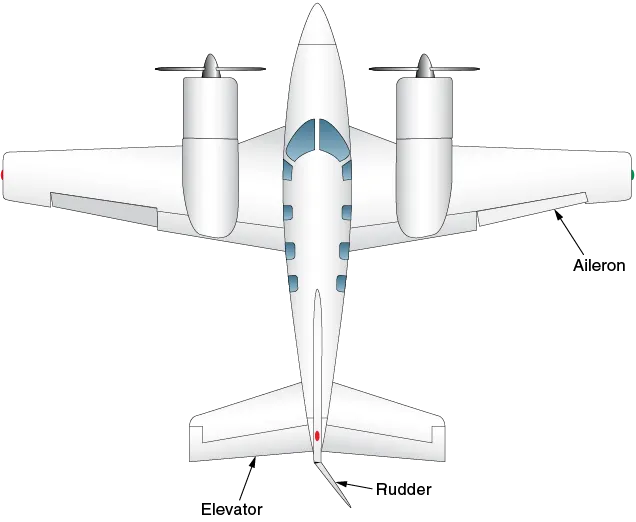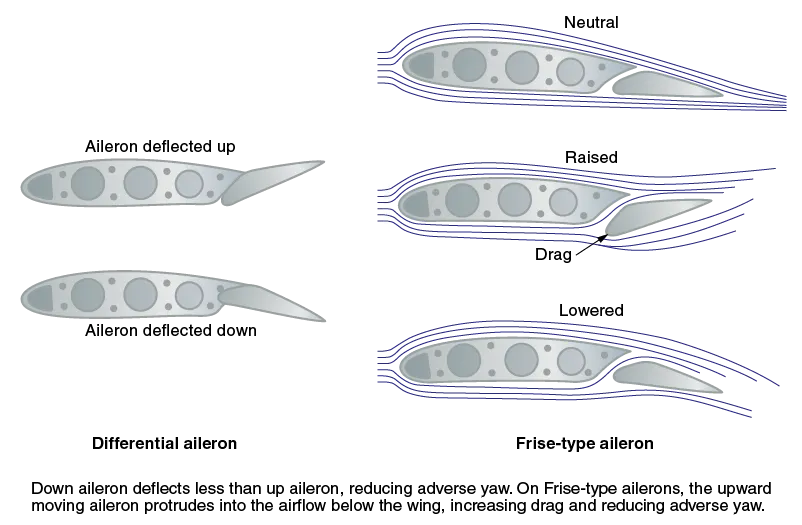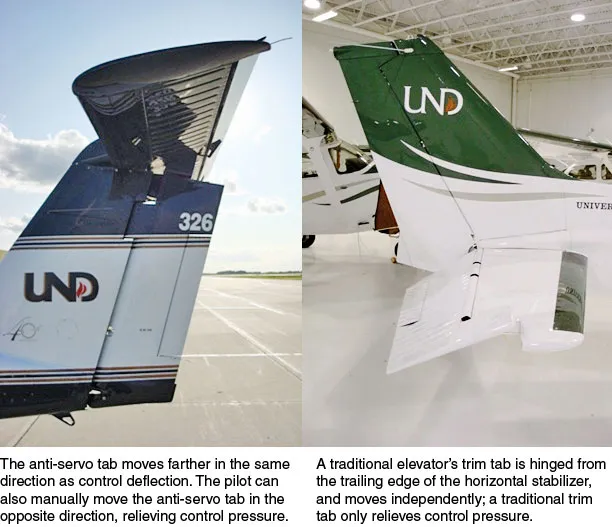1
Flight Controls
Chapter Focus for Multi-Engine Flight Control Systems
Flight controls on multi-engine aircraft are nearly identical to those used on single-engine aircraft with two exceptions: multi-engine aircraft tend to have larger control surfaces (sometimes requiring powered deflection), and universally require larger rudders and vertical stabilizer surfaces. The reasons for these differences are covered in this chapter.
You will also learn to identify and describe the primary and secondary flight controls found on multi-engine aircraft, and apply that knowledge to the operation and handling of the aircraft. Following that you will learn to apply the appropriate emergency action for the various abnormal and emergency events involving flight controls.
Aircraft flight control systems might seem like an elementary concept, but as aircraft weight and complexity increases so does the complexity of the flight control system. Each multi-engine type’s basic flight control system will have its own unique characteristics, so pilots must always review the Pilot’s Operating Handbook (POH) and receive competent flight instruction on that aircraft type prior to operating the aircraft.
Key Terms
(in the order they appear in this chapter)
primary flight controls
ailerons
single-engine operations
elevator
rudder
stabilator
spoiler
anti-servo tab
differential ailerons
Frise ailerons
deep stall
secondary flight controls
plain flap
split flap
Fowler flap
slotted flap
Primary Flight Controls
The primary flight controls are the ailerons, elevator, and rudder. These controls are used to maneuver the aircraft about the vertical, longitudinal, and lateral axis (pitch, roll, and yaw). See Figure 1-1.
Figure 1-1. Primary flight controls on a multi-engine aircraft.
Ailerons
There are three main types of aileron: plain, differential, and Frise. Some aircraft use a combination of these. The purpose of ailerons is simply to roll the aircraft. Most aircraft—both single- and multi-engine—use ailerons for roll; one exception to this is the Mitsubishi MU-2, which uses flight spoilers on the wings to reduce lift asymmetrically, causing the aircraft to roll. More commonly, multi-engine aircraft use flight spoilers and ailerons working together to create more responsive roll authority through all phases of flight. These unique systems utilize an interconnect system to tie-in flight spoiler movement with aileron movement.
single-engine operations: operating a multi-engine aircraft with one engine inoperative
On most light multi-engine aircraft, the basic flight control surfaces are mechanically driven using a series of cables, rods, and pulleys connected directly to the flight controls in the cockpit. Some multi-engine aircraft incorporate a system called rudder boost, which helps the pilot apply rudder force during one-engine-inoperative (or, single-engine) operations. Of course, flight control systems can vary greatly from aircraft to aircraft and the specifics for each aircraft you fly will be found in the POH and Aircraft Maintenance Manual (AMM).
Plain ailerons travel the same distance whether deflecting upwards or downwards. They are not designed to compensate for adverse yaw or reduce the likelihood of a wingtip stall at high angles of attack (AOA). Wingtip stalls occur because the down aileron increases the AOA on the outboard section of the wing, which can cause the tips to stall before the root. This is an undesirable characteristic that is overcome by incorporating a different aileron in aircraft design.
Differential ailerons are designed to reduce the chances of wingtip stalls as well as adverse yaw. This is done by restricting travel of the downward-moving aileron in comparison to the upward moving aileron. The name “differential” refers to the difference in travel distance of upward and downward moving ailerons. This technique is achieved through the rigging of the cable and pulley system used to move the ailerons.
Frise-type ailerons are designed to counteract adverse yaw. With a plain aileron, the downward moving aileron produces more lift as a result of the higher angle of attack. Due to the increase in lift there is an increase in induced drag. In a roll to the left, the right aileron produces more lift than the left; this also produces more drag, yawing the aircraft to the right away from the desired direction of travel. Frise ailerons deflect the upward moving aileron into the slipstream below the wing surface, causing more parasite drag on the descending wing. This will compensate for the induced drag caused by the down-going aileron (Figure 1-2).
Figure 1-2. Typical Frise-type and differential ailerons.
Frise-type and differential ailerons do not completely eliminate adverse yaw, they only reduce it. In order to counteract adverse yaw, the pilot must apply rudder in the direction of the turn to maintain coordination. Some multi-engine aircraft utilize a combination of Frise and differential ailerons to maximize the benefits and minimize adverse yaw and wingtip stalling characteristics.
Elevator and Rudder
stabilator: a single-piece, horizontal tail surface on an airplane that serves as both a horizontal stabilizer and an elevator.
The rudder and elevator are part of the empennage and are included to provide lateral and longitudinal control and stability. The rudder is hinged off of the vertical tail surface. Some light multi-engine aircraft—including the Piper Seminole (a common multi-engine training aircraft)—have a stabilator instead of an elevator (Figure 1-3).
Figure 1-3. Stabilator (left) with anti-servo tab compared with a traditional elevator (right).
The rudder on multi-engine aircraft tends to be much larger (heavier and harder to move) than on single-engine aircraft. This is because of the directional control requirements of operating a multi-engine aircraft with one engine failed.
There are four methods of increasing the force that the rudder creates: increase the surface area, increase the deflection, increase the airflow around the rudder, and increase the distance from the rudder to the center of gravity, which affects maximum available rudder force. This will impact the rudder effectiveness when operating a multi-engine airplane with one engine inoperative.
Light twins also incorporate rudder trim. The trim tab is located on the back of the rudder and may also serve as an anti-servo tab. Using the rudder trim wheel in the cockpit, the pilot can relieve rudder pressure. During single-engine operations, the pilot will have to remove any rudder trim applied in cruise before landing. This is to prevent directional control problems when power on the operative engine is reduced to idle.
The rudder’s anti-servo tab moves with the rudder but travels farther in the same direction, adding control force resistance when the pilot pushes the rudder pedals. This feature is designed to prevent the pilot from overstressing the rudder by making it more difficult to make full and abrupt rudder applications. Alternatively, the pilot can move the anti-servo tab manually using the rudder trim wheel in the cockpit in order to relieve control pressures. In essence, the same surface is used for two completely different purposes, which can cause confusion about the system’s function and operation, yet reduces the complexity of the aircraft system. Ultimately, aircraft manufacturers attempt to achieve the most efficient and effective design possible.
Stabilator
The Piper Seminole uses a stabilator in place of a horizontal stabilizer and elevator system. A stabilator is simply a fully moveable horizontal flight surface in contrast to the fixed horizontal stabilizer and moveable elevator used on other aircraft. The stabilator design provides more maneuverability for aircraft that are longitudinally stable.
Like the rudder, the stabilator includes an anti-servo and trim tab. The anti-servo tab is designed to prevent the pilot from overstressing the aircraft by increasing control pressure progressively as control surface deflection is increased. The anti-servo tab moves in the same direction as the stabilator, but slightly farther. For example, if the stabilator is at +10°, the anti-servo tab would be at +12°. The anti-servo tab on the stabilator can also be moved manually by the pilot (using the trim wheel or electric trim) to relieve control pressures much the same as an elevator trim tab (Figure 1-4).
Figure 1-4. Trim operation for an anti-servo tab and a traditional elevator work the same—the pilot moves the tab in the opposite direction of deflection, to relieve control pressure.
Tail Design
Some multi-engine aircraft incorporate a T-tail design, while others us...










